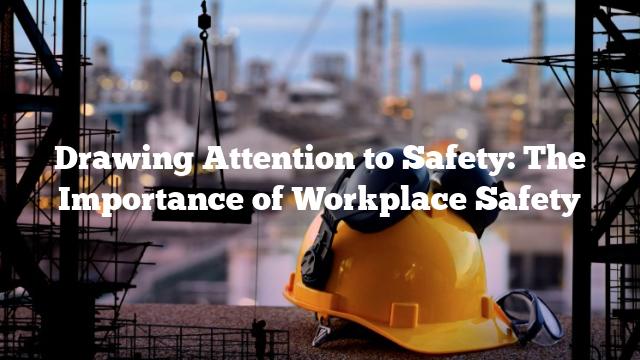Drawing for Safety Week: Importance, Tips, and Tutorials
Safety is a top priority in any workplace, and it’s crucial to take necessary precautions to prevent accidents and injuries. One effective way to promote safety is through drawing. Drawing for Safety Week is an annual event that encourages individuals and organizations to use artwork to raise awareness about safety practices, hazards, and prevention measures. In this blog post, we’ll explore the importance of drawing for safety, tips on creating effective safety drawings, and tutorials to get you started.
Why is Drawing for Safety Week Important?
Drawing for Safety Week is important because it provides a creative and engaging way to educate people about safety. Visuals are an effective tool in communicating information, especially when it comes to complex topics like safety regulations. Safety drawings can help workers understand the potential dangers in their workplace and how to prevent them. It also serves as a reminder for employees to follow safety protocols and procedures.
Facts about Drawing for Safety Week
– Drawing for Safety Week is celebrated annually in the third week of June.
– The event was first introduced in 1996 by the Occupational Safety and Health Administration (OSHA) in the United States.
– The purpose of Drawing for Safety Week is to promote awareness about safety hazards and encourage people to create safety-related drawings.
Tutorial of Drawing for Safety Week
Creating a safety drawing can seem intimidating, but it doesn’t have to be. Here’s a step-by-step tutorial to help you get started:
Step 1: Identify the message you want to convey. What safety hazard do you want to address? What message do you want to communicate?
Step 2: Choose the type of drawing you want to create. Will it be a poster, infographic, or comic strip?
Step 3: Sketch out your ideas on paper. This is the time to experiment with different layouts, font styles, and color schemes.
Step 4: Create a digital version of your drawing using software like Adobe Illustrator or Canva.
Step 5: Share your drawing on social media or display it in your workplace to promote safety awareness.
Tips of Drawing for Safety Week
Here are some tips to help you create effective safety drawings:
1. Keep it simple. Your message should be clear and easy to understand.
2. Use visuals to convey your message. A picture is worth a thousand words.
3. Incorporate humor. Humor can make your drawing more engaging and memorable.
4. Use bright colors. Bright colors can grab attention and make your message stand out.
5. Include a call to action. Encourage viewers to take action and follow safety protocols.
Question and Answer of Drawing for Safety Week
Q: Who can participate in Drawing for Safety Week?
A: Anyone can participate in Drawing for Safety Week, including individuals, organizations, and schools.
Q: What are some common safety hazards in the workplace?
A: Common safety hazards include slips, trips, falls, electrical hazards, and chemical exposure.
Q: What types of drawings are most effective for promoting safety?
A: Posters, infographics, and comic strips are effective types of drawings for promoting safety.
Q: How can I get involved in Drawing for Safety Week?
A: You can get involved in Drawing for Safety Week by creating your own safety drawing, sharing it on social media, or displaying it in your workplace.
Conclusion of Drawing for Safety Week
Drawing for Safety Week is an important event that promotes safety awareness through creative expression. By using drawings to convey safety messages, individuals and organizations can effectively communicate the importance of following safety protocols and procedures. With the tips and tutorials provided in this blog post, we hope you feel inspired to create your own safety drawing and participate in Drawing for Safety Week. Let’s work together to make our workplaces safer for everyone.
Recommendations:
- Health And Safety Site Inspection Template Where a health and safety representative has drawn your attention to the findings of an inspection they have. Health and safety annual audit action plan. Form 007 Hse Weekly Inspection…
- Safety Inspection Checklist There are several ways to perform safety inspections of a workplace task or job. Do you have a written safety and health program. Film Location Fire Safety Inspection Checklist Legal…
- Weekly Safety Inspection Checklist Are all employees trained in hazardous substances safety. Access all your safety inspection checklists and forms from your mobile and never worry about losing a piece of paper again. Ultimate…
- Safety Slogansquotes Safety sayings and quotes. Below you will find our collection of inspirational wise and humorous old safety quotes safety sayings and safety proverbs collected over the years from a variety…
- Food Safety Inspection Checklist Template Food safety checklists templates. You can access our templates below. Vehicle Safety Inspection Checklist Form Car Maintenance Tips Food safety checklists form the basis for a food safety system and…
- Safety Inspection Report Format Safety inspection report forms are forms that are used by professionals to report on the kind of safety violations if there are any of certain establishments by conducting a thorough…
- Safety Quotes Funny Try being a little creative and your message gets across. A big thank you to all of our readers who have contributed some excellent. Funny Workplace Safety Pictures Safety Slogans…
- Catchy Funny Safety Quotes And now that you know what some of them are you can start ignoring cheeky quotes that run on the lines of safety is great unless youre late or safetys…
- Health And Safety Inspection Form Safety inspections are essential to ensuring and effective safety program. More about download the free osh answers app. Workplace Health And Safety Inspection Forms Survey Templates And Alternatively they may…
- Fire Safety Slogans Posters Fire is so devastating that it can destroy homes and offices within few minutes. Per every million people the united states has the 10th highest death rate in the world.…
- Safety Quotes For The Workplace Display them around your workplace or add them to internal newsletters. Apr 25 2019 explore sotorioss board safety quotes for workplace on pinterest. Safety Quotes For The Workplace Safety In…
- Safety Quotes For The Workplace Funny In this post we are going to share with you a list of 57 funny safety slogans. Researchers reveal the top 10 most effective safety slogans ever click here. Funny…
- Safety First Baby Gate More buying choices 1431 7 used new offers summer top of stairs simple to secure metal gate white 29 42 inch wide. The safety 1 st lift lock swing gate…
- Safety Inspection Report Example Page 1 of 3. Formal inspections can take different forms and you and your representatives will need to agree the best methods for your workplace. Safety Report Templates 16 Pdf…
- Safety Plan Worksheet For Adults It is important that the safety plan worksheet is completed with the therapist and patient working together. 1 feeling safe being safe ety in an gency. Safety Plan Worksheet Therapist…
- Vehicle Safety Inspection Checklist When do i need a vehicle inspection checklist template. Missouris motor vehicle safety inspection program requires each vehicle for professional or personal use to go through a series of checks…
- Vehicle Safety Inspection Checklist Template Ontario Discover ideas about vehicle inspection. A vehicle inspection checklist is used to evaluate a vehicles working condition. 002 Vehicle Safety Inspection Checklist Template Ideas Magnificent Browse this free collection of…
- Safety Slogan Posters Images Following are the safety slogans and taglines. What others are saying industrial safety training servicescourses in india. Foam Sheet Safety Slogan Poster Rs 280 8 Piece Protector Safety slogans be…
- Construction Safety Inspection Checklist Template It can be completed in a single inspection or over a series of shorter inspections. Includes checks for first aid facilities fire prevention emergencies site security ppe and more. Construction…
- Workplace Safety Inspection Checklist Includes checks for fire prevention general safety vehicles. Date item condition follow up needed. Pshsa Sample Workplace Inspection Checklist The best checklist for your workplace is one that has been…
- Safety Quotes Pictures A group of wonderfully cared for confident individuals will generate great ideas. You are looking for the safety quotes which helps us to free from harm or danger. Safety Doesn…
- Construction Site Safety Inspection Checklist The standards referred to are south carolinas occupational safety and health standards for the construction industry as adopted from 29 cfr code of federal regulations part. Some construction companies will…
- Safety Precautions Inside The Laboratory Laboratories are dangerous and if safety precautions are not taken there is a possibility of mishaps occurring. Turn off gas when not in use 8. Laboratory Rules And Safety Organic…
- Safety First Slogan One of the major ways. 167 catchy and funny safety slogans for workplaces 2020 find the best catchy safety slogans for your workplace stop press. Labels Safety Slogans A big…
- Safety Inspection Report Template In line with this we have here safety report templates that you can download and use. Neglecting such reports could bring out legal and administrative consequences. Safety Report Templates 16…
- How to Create a Safety Drawing in Company Safety drawing in company is the best way to show the safety to everyone. Many accidents happen because of lack of understanding and lack of knowledge about the safety rules.…
- Huge Safety Slogans Complete List Made Your Safety… Browse through the safety slogans in 2022 suggestions below. The safety slogans is one of Safety Communication method which successful of safety campaign was measured. So Safety Slogans is so…
- Vehicle Safety Inspection Template Vehicle safety inspection checklist template overture is often used in vehicle safety inspection form vehicle inspection form inspection form inspection checklist template and business. Every day more and more people…
- Safety Slogans Funny Safety Quotes Safety slogans from russell t. 167 catchy and funny safety slogans for workplaces 2020 find the best catchy safety slogans for your workplace stop press. Posters Funny Safety Slogans K3lh…
- Safety Poster Hd The big list of free safety posters available for download. This can avoid serious workplace injury financial losses and even death. Workplace Safety Posters Downloadable And Printable Alsco Grab and…
Advertisement
Scroll to Continue With Content




